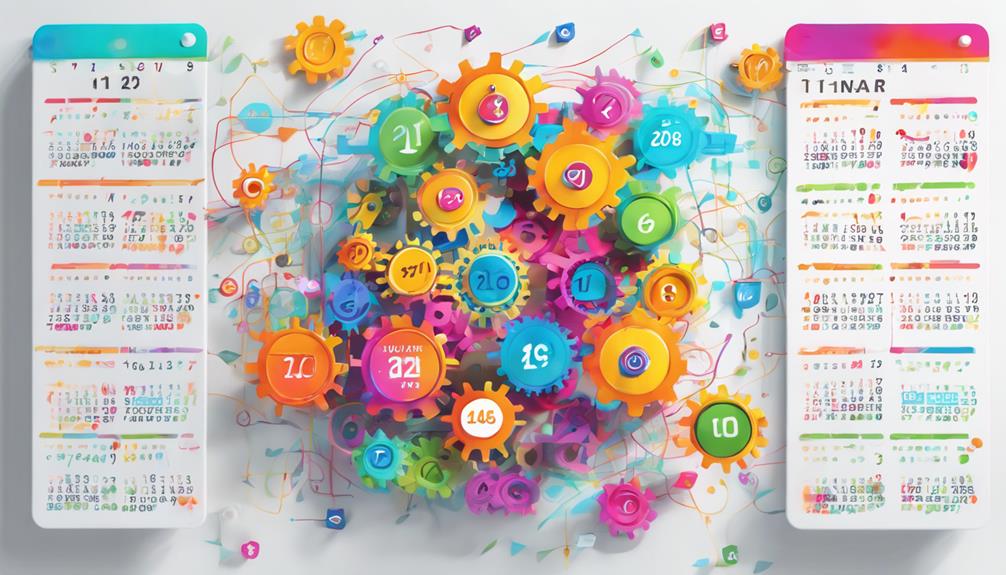When you're crafting content, understanding user intent is crucial. It's not just about what you want to say but what your audience needs to hear. By categorizing user intent into informational, navigational, and transactional types, you can tailor your message more effectively. Keyword optimization also plays a pivotal role, ensuring your content is both visible and relevant. But don't stop there—structure matters too. Short sentences, headings, and bullet points enhance readability. And let's not forget multimedia elements; they cater to various learning styles. So, how do you ensure your content stays fresh and engaging?
Key Takeaways
- Conduct thorough keyword research to align content with user search behavior and industry trends.
- Regularly update content based on performance analysis and industry trends to maintain relevance.
- Incorporate multimedia elements to enhance engagement and cater to diverse learning styles.
- Use headings, subheadings, and bullet points to improve readability and guide readers through the content.
- Analyze user intent to tailor content that meets specific informational, navigational, or transactional needs.
Understanding User Intent
Understanding user intent is crucial for creating content that truly resonates with your audience. You need to dig deeper into what your audience is really searching for. Are they looking for information, trying to make a purchase, or seeking a solution to a problem? By identifying the intent behind their searches, you can tailor your content to meet their specific needs and expectations. This means analyzing search queries and determining whether they're informational, navigational, or transactional.
To accurately gauge user intent, start by putting yourself in the user's shoes. Consider the context of their search and the type of questions they might have. Ask yourself: What problem are they trying to solve? What kind of answers are they looking for? By doing this, you'll ensure that your content isn't only relevant but also valuable.
Adaptability plays a key role here, as user intent can evolve. Stay informed about changing trends and behaviors to keep your content aligned with what users want.
Keyword Optimization Techniques
To effectively capture your audience's attention, mastering keyword optimization techniques is essential. By optimizing your content with the right keywords, you can significantly enhance its visibility and relevance.
It's about striking a balance between what your audience is searching for and what you want them to find. Here are three key techniques to guide you:
1. Research Thoroughly: Start by understanding what your target audience is searching for. Use tools like Google Keyword Planner or SEMrush to identify high-volume, low-competition keywords.
This helps ensure your content reaches the right people without getting lost in a sea of similar topics.
2. Prioritize Placement: Integrate keywords naturally throughout your content. Focus on placing them in strategic areas such as titles, headings, and the first 100 words.
This not only improves SEO but also makes your content more engaging and relevant to readers.
3. Maintain Relevance: Regularly update your keyword list based on trends and changes in your industry.
This adaptability ensures your content remains fresh and aligned with current search behaviors, keeping you ahead of the competition.
Enhancing Readability and Structure

Kicking off your content strategy with a focus on enhancing readability and structure can significantly boost engagement and comprehension. When your content is easy to read and well-organized, it ensures that readers stay focused and retain more information. Start by using short sentences and paragraphs, as they're easier to digest. Break up your text with headings and subheadings to guide your readers through your narrative. Lists and bullet points can also help emphasize key points without overwhelming your audience.
To further illustrate, consider the following table:
| Strategy | Benefit |
|---|---|
| Short Sentences | Enhances clarity and focus |
| Headings/Subheadings | Improves navigation |
| Bullet Points | Highlights key information |
Applying these strategies helps maintain a logical flow, which is crucial for reader retention. Active voice in your writing also plays a pivotal role in making your content direct and engaging. Avoid jargon unless it's necessary for your audience, and always prioritize clarity. With every piece of content, ask yourself: Is the structure aiding in understanding? Are your ideas presented logically? By continuously evaluating and adapting your approach, you ensure your content remains relevant and effective, meeting both reader expectations and your strategic goals.
Utilizing Multimedia Elements
Building on a strong foundation of readability and structure, incorporating multimedia elements can elevate your content strategy to new heights.
Multimedia doesn't just add visual appeal; it enhances user engagement, caters to various learning styles, and can even boost your SEO. By enriching your content with images, videos, or interactive elements, you can make your message more compelling and memorable.
To effectively use multimedia, consider these three strategies:
- Relevance: Ensure every element you include serves a purpose. Choose visuals and videos that complement and reinforce your message, not distract from it. For instance, infographics can simplify complex information, making it more digestible.
- Accessibility: Make sure your multimedia content is accessible to all users. Use alt text for images, provide transcripts or captions for videos, and choose formats that work across devices. This will broaden your audience and improve user experience.
- Loading Speed: Optimize multimedia files to maintain fast loading times. Use compressed images or lazy loading techniques to keep your site running smoothly. Slow-loading pages can frustrate users and negatively impact your search rankings.
Regular Content Updates

Regular content updates are essential for maintaining your website's relevance and authority. Search engines favor websites that consistently provide fresh, up-to-date information, which can boost your rankings. When you update content, you're signaling to both users and search engines that your site is active and engaged with current trends.
To effectively manage updates, analyze your existing content's performance. Identify which pieces are driving traffic and which aren't meeting expectations. This data-driven approach allows you to focus on updating high-impact articles, ensuring the most value from your efforts.
Additionally, pay attention to industry trends and user feedback to guide your updates, keeping your content aligned with audience interests. It's crucial to adopt a flexible schedule for updates. Some content may require frequent revisions, while other pieces might only need periodic checks.
Prioritize quality over quantity; a well-researched update will serve you better than frequent superficial changes. Use analytics tools to track the impact of your updates, adapting your strategy as needed.
Conclusion
To make your content truly resonate, focus on understanding user intent by categorizing it into informational, navigational, or transactional types. Optimize your keywords smartly and update them regularly to enhance visibility. Improve readability with short sentences, clear headings, and bullet points. Don't forget to include multimedia elements like images and videos to cater to different learning styles. Regularly update your content based on performance analysis and industry trends to keep it fresh and engaging for your audience.


Leave a Reply